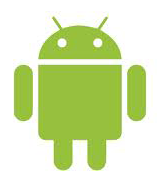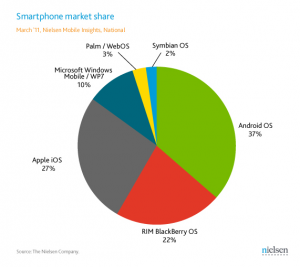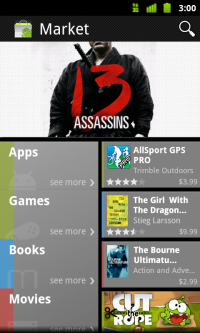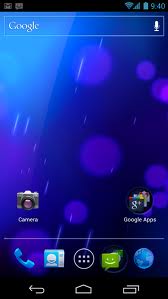Android
|
Contents
History
Android was created in Palo Alto, California, in October of 2003 by Andy Rubin, Rich Miner, Nick Sears, and Chris White to develop smarter mobile devices. Google purchased Android in August of 2005 and was marketed to handset makers and carriers on the basis that it was a flexible system that could be easily upgraded.[3] Android has been through multiple updates since its first release. The most recent version, Android 6.0 Marshmallow, was released in October, 2015. Android source code is available under free and open source software licenses, and Google's Linux kernel is available under the GNU license. [4][5]
Open Sourcing and Patenting, Control Issues
The Android Operating System is powerful and accomplishes many technological tasks with relative ease. The release of Android's open source code under a free software licensing system called Apache has allowed third party programmers to manipulate, revise, and innovate new applications for the Android Operating System and Android mobile markets. The open sourcing of Android's operating system lets programmers and developers tweak and make changes to Android's specifications.
While the community of developers working on Android has produced revolutionary applications for Google's growing share in the mobile market, the conflict of ownership and patenting will become more of a problem. For example, the Android operating system's ability to hold multi-core processors allows for advanced program capability, storage, and availability. If a developer were to enhance the processing ability of Android 2.2, would Google have a patented share or would the developer have full control and ownership? Third-party developers are beginning to wonder whether or not their programs and applications will be unique and owned by the creator, or if Google will authorize a policy in which they can patent or control a share of all profits from third party development of Android operating system programs and applications.
On August 15 of 2011, Google acquired Motorola Mobility for 12.5 billion dollars (USD). The acquisition included more than 17,000 issued Motorola patents and another 7,000 pending.[6] The sizable portfolio of patents will help protect Google's business from other competitors, such as Apple, and put Google on the offensive.[6]
Compatibility, Special Features, and Multi-Tasking
Andrid's success has been based on the fact that it is seemingly compatible with multiple platforms and able to operate to full capacity seamlessly. The ability of Android OS to multi-task (e.g. read pdf documents, surf the Internet, and play music) and bring 4G all while maintaining full capability as a mobile phone is what has made Android so popular. It stands as the prime competitor to Apple's iPhone in the smartphone market. Because of the release of the source code to several developers, Frank Feinbube, Professor of Information Technology Systems and Engineering at the Hasso Plattner Institute believes:"Android is setting the standard for mobile devices and will only improve with features such as SQLite for relational data storage, Bluetooth and wireless capability, ability to include data sharing between applications, and run multiple core libraries efficiently." [7] pp. 1-23Android features an integrated browser and media support for audio and video in several formats including MPEG4, MP3, AAC, AMR, JPG, PNG, and GIF. The ability to switch between 3G and 4G internet is also an attractive aspect of Android smartphones. It allows users the flexibility to switch between hardcore internet usage, and simple tasks such as checking the weather or email.
Smart TV
The customizable nature of Android have allowed the operating system to have functionality beyond just smartphones. Android has been adapted and is used on many smart TV devices, called Google TV. Customers can browse the internet and watch television simultaneously on their internet ready televisions.
Applications
Android Market
An online software store created by Google in 2008, the Android Market features a variety of applications organized around Apps, Games, Music, Books, and Movies. The market is not open source and the developers of the apps receive 70% of the profit, with the remaining 30% going to carriers and payment processors [8]. Developers in 29 countries may place applications on the market, while users from 131 countries may purchase and use the applications [9]. Android Market automatically filters applications that are compatible with the device and service provider you are using.[10] In March, 2012, the Android Market app was rebranded to the name Google Play.[11]
Ethical Concerns
The Android Market causes a potential security threat for users in that they may purchase applications that contain viruses. In 2011, the application DroidDream was released to the market and this application allowed hackers to access personal information on the infected phones[12] The market's use of anonymity promotes this type of behavior by decreasing the chance that the hackers will be identified and thus decreasing the chances that the hackers will be held accountable for their actions. There are many more ethical concerns with the Android Market compared to Apple's App Store. Since Android utilizes open software, it is relatively easy to program applications and make them available for download in the Android Market. Apple, on the other hand, has a long, grueling process for approving applications, which helps to ensure safe and secure programs.
"Patent Wars"
Many smartphone manufacturers use Android technology as the operating system for their devices. As a result, many smartphones currently on the market run very similar, if not identical operating system software. The competitive nature of the smartphone market has led to different software patent owners suing phone manufacturers for infringing on patents via the software that they ship on their phones, especially when competing against other technology giants such as Apple, Microsoft, and Samsung.
The "open" nature of Android's technology has made Android phone manufacturers easy targets for those looking to gain on patent infringement. Apple has filed many patent infringement claims against Android phone manufacturers, with former CEO Steve Jobs going so far as to characterize Android as a "stolen product."[13] These claims happened to occur while Android's smartphone marketshare was in a state of rapid growth.[14] If these lawsuits begin to gain any traction in the legal system, it may set a precedent against open source software. Any implementation of the software could potentially be negated by a patent infringement claim in one of the thousands of patents that a smartphone contains. The International Trade Commission poses an imminent threat to ban the importation of devices that run the Android operating system.[14]
Open Source
Android saw a quick rise to popularity not only because of its creator, Google, but also through its open source nature. The code is "open" for use by anyone to use and re-implement. This non-proprietary nature differentiates it from Apple's App Store. The App Store is extremely careful in allowing apps to be sold in its domain. This causes much grief among developers who complain about the fact that Apple is not reasonable with its responses but ultimately leads to a more elitist store; only well-developed apps are allowed entrance. The Android Market is much more liberal in its allowances. In fact, it has almost no restrictions for its entrants. The few things it cares about are listed here:
- Sexually Explicit Material
- Violence and Bullying
- Hate Speech
- Impersonation or Deceptive Behavior
- Personal and Confidential Information
- IP Infringements
- Illegal Activities
- Gambling
- Malicious Products[15]
Apple's App Store restrictions are very exhaustive and cover thousands of binding policies. This delineation between the two has led to polarized content. Android sports an explicit market of applications that bend the rules. As a result of its open-sourced nature, Android's content is not quite as refined as that of Apple's and its applications tend to be a bit less stable.
Google, in as much as one can own an open-source project, "controls" Android development and determines its upcoming features. Because of this relationship, some features are pushed to the Android system before any other markets get access. For example, Google Voice, a popular VoIP service was exclusively offered on the Android Market. More recently, Google has launched a new, indoor, map system that enables users to view the layout of buildings to more easily navigate to their destination. There is currently no set date to push this feature to the Apple App Store.
Another differentiating factor about its open-source nature and relationship with Google is inter-operability. The Android operating system has multiple formats for different devices and can be used by many different carriers on many proprietary devices. Users are also allowed to modify the Android operating system as well through a process known as rooting, which is the equivalent of the popular iOS "jailbreak" modification. Rooting is a process that allows you to attain root access to the Android operating system code. It gives you privileges to modify the software code on the device or install other software that the manufacturer wouldn't normally allow you to. This raises potential ethical issues because Android users can modify Google's default Android operating system and create illegitimate versions that might be sold off to unaware customers. However, the benefit of being able to root the Android system is that users are allowed to be more innovative with the Android system, creating innovative versions and features that might be incorporated into future Android systems and benefit the creativity and technological advancement of Google and its Android flagship phones.
Google Voice
Google Voice sports a free VoIP service that allows users to take on a wholly new number (or keep their own for $20). Android and Google Voice integration is extremely powerful and has allowed many users to bypass a significant portion of their carrier charges. Although many companies have complained about this, it is still profitable to use the Google Android operating system, a system that is increasingly rivaling Apple's iOS.[16]
Google - Possibly Unethical Actions
While Android is claimed to be open source, Google has not fully the full source code used in Android 3.0 as of October of 2011. Android includes a header file based on one distributed with code which is protected under GPLv2.[17] Compiling android using the GPLv2 licensed code could mandate that either Android or both Android and applications for the platform release their source code. Therefore, Google implemented their own version of the functions and structs outlined by the header file to avoid this mandate. However, the GPLv2 can be interpreted as implying not only that a header file is covered as a derivative work, but also that an individual loses any further right to redistribute the end product of compilation even if they release source code in compliance with the license unless they obtain the permission of every contributor.[18][19]. However, Linus Torvalds also further points out that including such header files is necessary for a program to interface with libraries and even the kernel. [19] In general, this means that it is impossible to compile code that runs on an operating system without including such header files, and that using this logic any code that includes header files referring to GPLv2 code must also use the same license. However, this interpretation is practically unenforceable because of the sheer number of people involved in any given project, each of which often depends on many other similar projects[19][20]It may also be impossible to gain the permission of some authors if they are deceased.
More importantly, using a header file does not violate the ethical goals of the GPL according to Richard Stalman and Linus Torvalds.[21][19] Although the Free Software Foundation believes that the permanent rights-loss interpretation is a real problem, it does not see Google as accountable or its actions as immoral. [20] Instead it names itself as the most accountable for the problem because it wrote the GPLv2 without the expectation that software licensed under it would having hundreds of contributing authors or wide scale adoption. [20] They suggest solving the problem by licensing future versions of Linux source code under the GPLv3, which explicitly outlines when and how distribution rights to software are restored. [20].
It is still possible to argue that the act of creating code that matches a description created by the Linux community is exploitative even though there are completely interchangeable open-source replacements for the structs and functions the header defines. However, on the whole Google is arguably a net-contributor to the open source community in many ways such as the Summer of Code open source event it sponsors or its Google Code repositories. Therefore, even if Google may be doing something that is slightly questionable, the sum of the actions it performs is tends towards "good" in Floridi's sense of expanding the infosphere by helping others to create projects that accelerate its growth.
Version History
| Version Number | Version Name | Released Date |
|---|---|---|
| 1.0 | Android 1.0 | September 23, 2008 |
| 1.1 | Android 1.1 | February 9, 2009 |
| 1.5 | Cupcake | April 30, 2009 |
| 1.6 | Donut | September 15, 2009 |
| 2.0 | Eclair | October 26, 2009 |
| 2.2 | Froyo | May 20, 2010 |
| 2.3 | Gingerbread | December 6, 2010 |
| 3.0 | Honeycomb | February 22, 2011 |
| 4.0 | Icecream | October 19, 2011 |
| 4.1 | Jellybean | June 27, 2012 |
| 4.4 | Kitkat | October 31, 2013 |
| 5.0 | Lollipop | November 12, 2014 |
| 6.0 | Marshmallow | September 29, 2015 |
Lawn Statues
For each new version of Android released, Google adds another statue to the lawn in front of Building 44, where the Android team is based. Beginning with Android version 1.5, the codenames for the versions have been named after desserts. The statues are created in New Jersey by Themendous and then transported to the Googleplex in Mountain View, CA. Generally, the statue is unveiled a few days before the version of Android is released. In keeping with Google's humor, each version of the Android software begins with the next letter in the alphabet. Thus, the most recent version is a "Jelly Bean" representing the 10th version. The first two versions, in theory beginning with "a" and "b", do not have public codenames. [22]
Marketing
The Android logo was designed by Ascender Corporation. The Android green is the color that represents the Android operating system. The print color is PMS 376C and the RGB color value in hexadecimal is #A4C639, as specified by Android brand. [23]
Android holds an estimated 2.8% share of worldwide smartphone shipments, and by Q4 2010 had grown to 33% of the market. Android continues to be a top-selling smartphone platform. By Q3 2011, Android held and estimated 52.5% of the smartphone market. [24]
In May 2010, Androids first quarter U.S. sales surpassed that of the rival iPhone platform. According to a report by the NPD group, Android achieved 25% smartphone sales in the US marked, which was up 8% from the December quarter.
iPhone and Android OS has been battling back and forth for years for a position at the top. In the Q2 2010, Apple iOS was up by 11%, indicating that Android and iPhone still have to compete with heavy consumer demand. [25]
As of November 16, 2011, Google reported that there are about 200 million Android devices had been activated. [26]
As of September 12, 2012, Google announced that they have reached 500 million Android devices activated.[27]
See Also
External Links
References
- ↑ Android Developers Blogspot
- ↑ Arthur, Charles. Mobile generating equivalent of $2.5bn a year, says Google chief. Guardian. 14 October 2011. Retrieved 11 December 2011.
- ↑ Elgin, Ben. Google Buys Android for Its Mobile Arsenal. Bloomberg Businessweek. 16 August 2005. Retrieved 11 December 2011.
- ↑ Android (operating system). Wikipedia. Retrieved 11 December 2011.
- ↑ Licenses. Android Open Source Project. Retrieved 11 December 2011.
- ↑ 6.0 6.1 Mclean, Mike. Google and Motorola - A match made in patent heaven? EDN. 15 September 2011. Retrieved 11 December 2011.
- ↑ Feinbube, Frank. "Android: Operating Systems and Middleware." Hasso Plattner Institute, IT Systems and Engineering, 17 November 2011. Web. 11 December 2011.
- ↑ Eric Chu (22 October 2008). "Android Developers Blog: Android Market: Now available for users". Android Developers Blog. Retrieved 12 December 2011.
- ↑ "Supported locations for merchants". Android Market Help
- ↑ Android Market [1]
- ↑ Google Rebrands [2]
- ↑ "The Mother Of All Android Malware Has Arrived: Stolen Apps Released To The Market That Root Your Phone, Steal Your Data, And Open Backdoor | Android News, Reviews, Apps, Games, Phones, Tablets, Tips, Mods, Videos, Tutorials". Android Police. Retrieved 12 December 2011.
- ↑ Dignan, Larry. Steve Jobs: Android a 'stolen product.' ZDNet. 20 October 2011. Retrieved 12 December 2011.
- ↑ 14.0 14.1 The Android Patent War. The Wallstreet Journal. 05 December 2005. Retrieved 12 December 2011.
- ↑ Android Market Developer Program Policies. Android. Retrieved 12 December 2011.
- ↑ Google Voice
- ↑ Brooker, Brandan. Android: The OS of the Future. Blogspot: brookersection. 7 October 2011. Retrieved 12 December 2011.
- ↑ [3]
- ↑ 19.0 19.1 19.2 19.3 Android foes still beating GPL non-compliance drum,[4]
- ↑ 20.0 20.1 20.2 20.3 Android GPLv2 termination worries: one more reason to upgrade to GPLv3, [5]
- ↑ [6]]
- ↑ Android Statues [7]
- ↑ Washington Post-4chan
- ↑ Gartner Newsroom - Mobile Sales Increase
- ↑ CNET Android hits top spot in mobile market
- ↑ CNET Google: 200M active Android devices
- ↑ Shankland, Stephen. 09-12-2012. Google: 500 million Android Devices Activated




